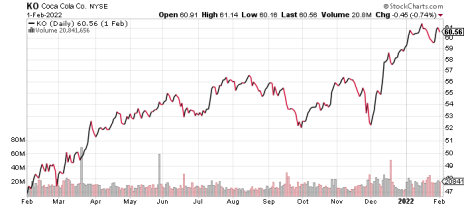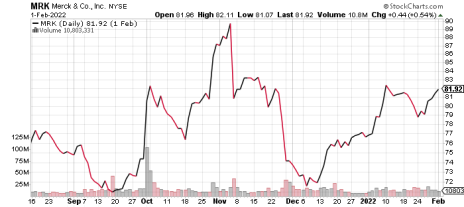Growth & Income
Portfolio
Growth & Income Portfolio stocks are generally higher-quality, larger-cap companies that have fallen out of favor. They usually have some combination of attractive earnings growth and an above-average dividend yield. Risk levels tend to be relatively moderate, with reasonable debt levels and modest share valuations.
| Growth/Income Portfolio | |||||||
| Stock (Symbol) | Date Added | Price Added | 2/1/22 | Capital Gain/Loss | Current Dividend Yield | Price Target | Rating |
| Bristol-Myers Squibb (BMY) | 04-01-20 | 54.82 | 64.25 | 17.2% | 3.4% | 78.00 | Buy |
| Cisco Systems (CSCO) | 11-18-20 | 41.32 | 55.43 | 34.1% | 2.6% | 66.00 | Buy |
| Coca-Cola (KO) | 11-11-20 | 53.58 | 60.86 | 13.6% | 2.7% | 64.00 | Buy |
| Dow Inc (DOW) * | 04-01-19 | 53.50 | 61.39 | 14.7% | 4.6% | 78.00 | Buy |
| Merck (MRK) | 12-9-20 | 83.47 | 81.91 | -1.9% | 3.4% | 99.00 | Buy |
| CUSA Valuation and Earnings | |||||||
| Growth/Income Portfolio | |||||||
| Current price | Current 2022 EPS Estimate | Current 2023 EPS Estimate | Change in 2022 Estimate | Change in 2023 Estimate | P/E 2022 | P/E 2023 | |
| BMY | 61.86 | 7.83 | 8.14 | 0.0% | 0.5% | 7.9 | 7.6 |
| CSCO | 61.80 | 3.42 | 3.68 | 0.0% | 0.0% | 18.1 | 16.8 |
| KO | 60.23 | 2.44 | 2.60 | 0.4% | 0.0% | 24.7 | 23.2 |
| DOW | 58.49 | 6.25 | 6.36 | -1.0% | 0.3% | 9.4 | 9.2 |
| MRK | 76.87 | 7.25 | 7.23 | 0.6% | 1.0% | 10.6 | 10.6 |
Current price is yesterday’s mid-day price.
CSCO: Estimates are for fiscal years ending in July.
Bristol Myers Squibb Company (BMY) shares sell at a low valuation due to worries over patent expirations for Revlimid (starting in 2022) and Opdivo and Eliquis (starting in 2026). However, the company is working to replace the eventual revenue losses by developing its robust product pipeline while also acquiring new treatments (notably with its acquisitions of Celgene and MyoKardia), and by signing agreements with generics competitors to forestall their competitive entry. The likely worst-case scenario is flat revenues over the next 3-5 years. Bristol should continue to generate vast free cash flow, has a solid, investment-grade balance sheet, and trades at a sizeable discount to its peers.
If Bristol can demonstrate at least the reasonable potential for merely stable revenues during its patent expiration period, which we believe will happen, the shares are remarkably undervalued. On a free cash flow yield basis, assuming an average of $15 billion/year, the shares trade at a 11% free cash flow yield.
Bristol-Myers is expected to report earnings of $1.80/share when it reports on February 4.
BMY shares rose 4% in the past week and have about 20% upside to our 78 price target. Valuation remains low at 8.3x estimated 2022 earnings, compared to 11x or better for its major peer companies. The stock’s 8.0x EV/EBITDA multiple is similarly cheap, compared to 9-10x or better for peers.
Either we are completely wrong about the company’s fundamental strength, or the market must eventually recognize Bristol’s earnings stability and power. We believe the earning power, low valuation and 3.3% dividend yield that is well-covered by enormous free cash flow make a compelling story. BUY
Cisco Systems (CSCO) is facing revenue pressure as customers migrate to the cloud and thus need less of Cisco’s equipment and one-stop-shop services. Cisco’s prospects are starting to improve under a relatively new CEO, who is shifting Cisco toward a software and subscription model and is rolling out new products, helped by its strong reputation and entrenched position within its customers’ infrastructure. The company is highly profitable, generates vast cash flow (which it returns to shareholders through dividends and buybacks) and has a very strong balance sheet.
There was no significant company-specific news in the past week.
CSCO shares fell 2% in the past week and have 20% upside to our 66 price target. The dividend yield is an attractive 2.7%. BUY
The Coca-Cola Company (KO) is best-known for its iconic soft drinks yet nearly 40% of its revenues come from non-soda beverages across the non-alcoholic spectrum. Its global distribution system reaches nearly every human on the planet. Coca-Cola’s longer-term picture looks bright but the shares remain undervalued due to concerns over the pandemic, the secular trend away from sugary sodas, and a tax dispute which could cost as much as $12 billion (likely worst-case scenario). The relatively new CEO James Quincey (2017) is reinvigorating the company by narrowing its oversized brand portfolio, boosting its innovation and improving its efficiency, as well as improving its health and environmental image. Coca-Cola’s balance sheet is sturdy, and its growth investing, debt service and dividend are well-covered by free cash flow.
There was no significant company-specific news in the past week.
KO shares rose 1% in the past week and have about 6% upside to our 64 price target.
While the valuation is not statistically cheap, the shares remain undervalued given the company’s future earning power and valuable franchise. Also, the value of Coke’s partial ownership of a number of publicly traded companies (including Monster Beverage) is somewhat hidden on the balance sheet, yet is worth about $23 billion, or 9% of Coke’s market value. This $5/share value provides additional cushion supporting our 64 price target. KO shares offer an attractive 2.8% dividend yield. BUY
Dow Inc. (DOW) merged with DuPont to create DowDuPont, then split into three companies in 2019 based on product type. The new Dow is the world’s largest producer of ethylene/polyethylene, the most widely used plastics. Investors undervalue Dow’s hefty cash flows and sturdy balance sheet largely due to its uninspiring secular growth traits, its cyclicality and concern that management will squander its resources. The shares are driven by: 1) commodity plastics prices, which are often correlated with oil prices and global growth, along with competitors’ production volumes; 2) volume sold, largely driven by global economic conditions, and 3) ongoing efficiency improvements (a never-ending quest of all commodity companies). We see Dow as having more years of strong profits before capacity increases signal a cyclical peak, and expect the company to continue its strong dividend, reduce its pension and debt obligations, repurchase shares slowly and restrain its capital spending.
Industry conditions will likely be strong for a while. Dow remains well-positioned to generate immense free cash flows over the next few years, even as the stock market cares little about cash but rather is focused on the incremental newsflow related to economic growth, energy prices and any industry capacity changes. In the meantime, Dow shareholders can collect a highly sustainable 5.0% dividend yield while waiting for more share buybacks, more balance sheet improvement, more profits and a higher valuation.
On Thursday, January 27, Dow reported a strong quarter. Revenues of $14.4 billion grew 34% compared to a year ago and were about 1% above consensus estimates. Earnings of $2.15/share compared to $0.81 a year ago and were a cent above consensus estimates. Also, the company guided for a strong first quarter, with adjusted EBITDA up about 20% from a year ago and about 16% above prior analyst estimates.
Higher prices drove the strong results. Fourth-quarter pricing rose 39%, faster than the 34% revenue increase, as volumes fell. Operating expenses including research and development, sales, and overhead, rose only moderately. Helping Dow’s results are its joint ventures. In 2021, these generated $250 million in dividends to Dow, much higher than in 2020.
Dow’s free cash flow – a key part of our thesis – was impressively strong at $2.1 billion, bringing the full-year free cash flow to $5.7 billion.
For perspective, this full-year total is equivalent to 14% of its market cap of $42 billion. And, this total understates the run-rate pace, as it includes a $(228) million negative free cash flow in the first quarter partly due to one-off problems in Texas and elsewhere, and includes a $1.2 billion pension contribution. If annualized, the fourth-quarter pace of $8.4 billion is the equivalent of 20% of the company’s market value.
Dow is not neglecting its core business to generate this cash flow: it continues to invest heavily in a wide range of new growth, efficiency, decarbonization and other initiatives. The company is also returning much of the cash flow to investors either directly through dividends and buybacks (totaling $3.1 billion in 2021) or indirectly by reducing the company’s pension and debt liabilities (totaling $8.9 billion for 2021).
Is this pace of cash flow production sustainable? Dow is driven by volumes and pricing. We see pricing and volumes remaining relatively stable for 2022, which would allow the company to replicate its 2021 cash flow production, as higher capital spending will be at least offset by lower pension contributions. Dow’s first-quarter guidance points to about $2.7 billion of EBITDA, down about $200 million from the fourth quarter but about 20% higher than the year-ago quarter and supportive of our “stronger for longer” view.
Overall, Dow shares remain inexpensive. The stock price is rising but so are earnings and cash flow estimates, such that the already-low valuation multiples aren’t increasing. Holding back Dow shares are concerns about the sustainability of the current price and volume trends later in 2022 and into 2023 and beyond. We continue to hold to our “stronger for longer” thesis and our 78 price target and watch the dividends and internal cash flow build up while we wait.
Dow shares rose 7% in the past week and have 28% upside to our 78 price target. BUY
Merck (MRK) shares are undervalued as investors worry about Keytruda, a blockbuster oncology treatment (about 30% of revenues) which faces generic competition in late 2028. Also, its Januvia diabetes treatment may see generic competition next year, and like all pharmaceuticals it is at risk from possible government price controls. Yet, Keytruda is an impressive franchise that is growing at a 20% rate and will produce solid cash flow for nearly seven more years, providing the company with considerable time to replace the potential revenue loss. Merck’s new CEO, previously the CFO, is accelerating Merck’s acquisition program, which adds return potential and risks to the story. The company is highly profitable and has a solid balance sheet. It spun off its Organon business in June and we think it will divest its animal health segment sometime in the next five years.
The consensus estimate for Merck’s upcoming fourth-quarter report is $1.52/share.
Merck shares rose 3% in the past week and have about 21% upside to our 99 price target.
Merck produces generous free cash flow to fund its current dividend (now yielding 3.4%) as well as likely future dividend increases (the company recently raised its dividend by 6%), although its shift to a more acquisition-driven strategy will slow the pace of increases. BUY





